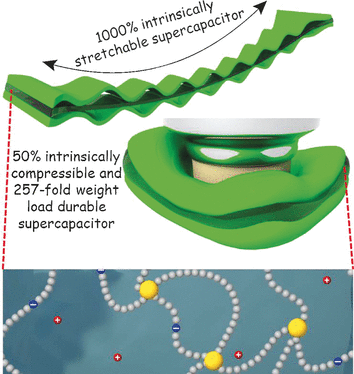Jul
6
Stretchable Compressible Wearable Supercapacitors
July 6, 2017 | 1 Comment
Chinese scientists have introduced an extraordinarily stretchable and compressible polyelectrolyte. The new electrolyte when combined with carbon nanotube composite paper electrodes, forms a supercapacitor that can be stretched to 1000 percent in length and compressed to 50 percent in thickness without gaining and not losing capacity.

Superstretchable supercompressible supercapacitor that may apply to wearable electronics. Image Credit: City University of Hong Kong, Hong Kong SAR, China. Click image for the largest view.
The potential for flexible, wearable electronics that require equally flexible, wearable power sources seems to be on the horizon. The polyelectrolyte, stretched more than 10 times its length and compressed to half its thickness retaining full functionality, without breakage, cracking, or other damage to its structure or performance.
The group’s research paper has been published in Angewandte Chemie International Edition.
Supercapacitors bridge the gap between batteries, which are merely energy-storing devices, and normal capacitors, which release and take up electric energy very quickly but cannot store so much energy.
With their ability to charge and release large amounts of electric power in a very short time, supercapacitors are preferably used in regenerative braking, as power buffers in wind turbines, and, increasingly, in consumer electronics such as laptop computers and digital cameras.
To make supercapacitors fit for future electrics demands like, for example, wearables and paper electronics, Chunyi Zhi from the City University of Hong Kong and his colleagues are searching for ways to endow them with mechanical flexibility.
Electrolytes in supercapacitors are often based on polyvinyl alcohol gels. To make such gels mechanically more flexible, elastic components like rubber or fibers must be added.
Zhi’s new electrolyte is based on a different principle. It is composed of a polyacrylamide (PAM) hydrogel reinforced with vinyl-functionalized silica nanoparticles (VSPNs). This material is both very stretchable thanks to the cross-links by the vinyl-silica nanoparticle and highly conductive thanks to the nature of the polyelectrolyte, which swells with water and both holds and transfers ions.
Zhi explained, “VSNPs cross-linkers serve as stress buffers to dissipate energy and homogenize the PAM network. These synergistic effects are responsible for the intrinsic super-stretchability and compressibility of our supercapacitor.”
To assemble a working supercapacitor with this polyelectrolyte, two identical carbon nanotube composite paper electrodes were directly paved on each side of the pre-stretched polyelectrolyte film. Upon release, a wavy, accordion-like structure developed, showing surprising electrochemical behavior.
The scientists learned, “The electrochemical performance gets enhanced with the increase of strain.” And the strain was enormous, the supercapacitor sustained 1000 percent stretch and 50 percent compression at even higher or equal capacity. This flexibility makes this polyelectrolyte very attractive for new developments including wearable electronics.
Something of a remarkable breakout for a new branch of the technology. Supercapacitors still are not battery level storage devices. Yet for low load and draw devices they may well do nicely. Let the new product development begin!
Comments
1 Comment so far


Good post! Thank you for sharing those useful message with us.